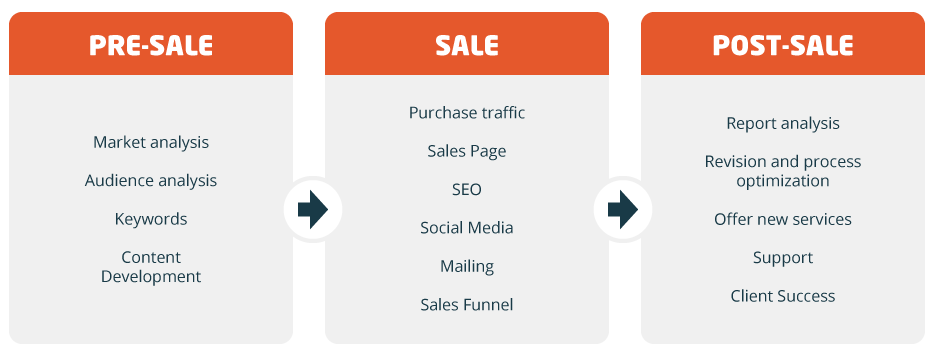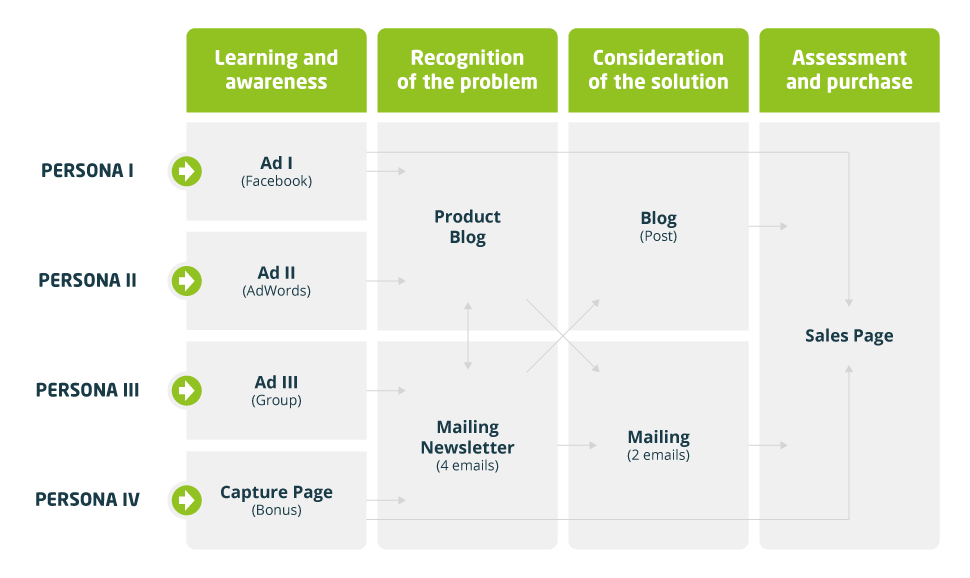
Sales Process – Part I: planning a structured process
Learning how to structure a sales process plays a crucial role in the success of your business. Check out our first post on the Sales Process!

What will we see in this post
An essential aspect that may lead to a successful business is knowing how to structure a sales process that is coherent and clear.
But what would that be?
A sales process is comprised of the steps taken by the client until the actual purchase of the product and its function is to define the path this client will follow all the way up to the shopping cart, besides being a guide for commercial and marketing strategies.
The structuring of these steps is fundamental in order to put all your planning into practice, and help define the strategies that will attract your target-audience, especially in the digital market. One of the most difficult things about structuring a sales process is to identify and determine the correct steps, because there are many different models you can follow… It will vary depending on the business and on the product being sold.
To make it simpler and easier to understand, let’s define three basic stages: pre-sale, sale and post-sale. Each of these stages has specific subcategories that should be taken into consideration when you structure your process.
At the pre-sale stage, the first thing you need to do is choose the market you intend to act in and analyze it. A niche is a segment in the market with particular characteristics and composed by a group of people with a higher propensity to purchase a specific product.
When choosing your niche, the more specific you are, the more relevance you will achieve, however, the lower will your selling potential be. With this in mind, you have to try to find a balance between niche size and competition.
To help you in this analysis, you should also consider the following aspects:
- Promotion costs;
- Niche size. To find this out, Google Trends is an excellent tool;
- Previous knowledge and authority over the subject;
- Competition already in business;
- Consumer buying power in your audience;
- Average price of products;
- Interest and engagement of the clients in the niche.
After you have chosen the niche, the next step is to know your audience. In order to do so, you can do some research or survey on Facebook, blogs, databases such as Consumer Barometer from Google, Facebook Audience Insights and even paid surveys like Google Consumer Survey. To guide your research about the clients you should think about two basic components, your target-audience and you persona.
- Target-audience: is the set of characteristics which relate to the potential buyers of your product: age, gender, level of education, line of work, etc. From these characteristics and information, you will create your buyer persona, or simply, persona.
- Persona: is the representation of all the characteristics of your target-audience in an ideal character that will buy your product. This is a very important technique, because it helps you interpret the habits, desires, needs and fears of the client, leading to a better understanding to guide your strategies. In this process of creation, you don’t have to identify only one kind of profile, you will probably identify the profile of a person who will be interested in buying your product, the person who can influence the purchase, of the decision-maker that will determine the purchase and the one who is not interested in the product. Besides all that, the personas can also be divided into subcategories:
- Logical: these are people who are skeptical, independent and who focus on problem-solving, fast answers, with information in a logical, systematic and easy to find way.
- Impulsive: these are immediatist people, who act on impulse, making the decision to buy very quickly. With these, you must direct the client to the buying button very fast, preventing them from having time to give up.
- Attentive: these are people who demand a closer contact, because the credentials of your product, authority and tradition carry a lot of weight on their decision, and therefore your involvement is crucial to provide the safety this client requires to make the purchase.
- Aggressive: these are competitive people, who are ambitious and trust their instincts to achieve gains, and therefore will be skeptical about your product, demanding you to be straight-forward and present the advantages your product has over the competition.
The number of personas you will create in this process doesn’t matter. What really matters is knowing that for every persona created, you have to use a different approach in the communication, because they are different.
After defining the niche and understanding your client, you must determine the keywords that relate to you product, niche, and client. They are important to specify the relevant content that must be created. To help you in the process of choosing keywords, you can use Google Adwords: Keyword Planner, and the words can be used for the purchase of ads and in Search Engine Optimization (SEO).
When you know your niche, your client and the main themes that they are interested in, you should start the process of creating content that will be used throughout the sales process, in the description of your product, in short, in all communication.
It is crucial that you understand the real needs of your audience in order to develop a product that is capable of providing a solution to the clients, helping them to save time, save money, or by providing specific knowledge that is truly useful.
At the same time you are developing your product, you should set the purchase journey of the client, using the target-audience and personas as reference points.
To guide you in the structuring of this journey, you can take into consideration the following developing stages of your client up to the purchase:
- Learning and awareness: this is the beginning of the process, that is, the consumer can’t yet identify that there is a need or a problem, and therefore you must provide content that raise the interest in the topic and the problem you have set out to solve.
- Recognition of the problem: in this step the client already has more knowledge about the topic and can identify a specific opportunity or problem in his everyday life. Thus, you will arouse the will to look for more information about the topic and discuss the possible solutions and problems.
- Consideration of the solution: in this step, you should present to your client your product or service as a possible solution to the problem, arousing interest in the solution.
- Assessment and purchase: in this final step, you have to present your product, the advantages it brings, and break the objections from the customer, because this is the decision-making moment about making the purchase or not. In this moment, your product is presented as a solution for the previously discussed problem.
Take a look at an example of the consumer decision journey:
Your clients won’t necessarily go through every step in the process. However, systematically thinking about it will help you to determine strategies to lead the client to the purchase in a more targeted and specific way, increasing the sale potential.
All these steps are complementary in the structuring your pre-sale process and will have a direct impact in the subsequent steps in the sales process.
After the pre-sale and research planning, you should sign up for Hotmart as an Affiliate or a Producer of a digital product.
Hotmart offers the best tools to structure, control and follow your work in the digital market, for free, and you also have access to the Affiliate Program that will potentialize your business even more, in a simple and easy way.
After your registration with Hotmart, if you should work as an Affiliate, promoting digital products, the planning can also be used.
Knowledge of the market you wish to work in, of your audience and competition is essential to determine which products to promote, the correct approach in the promotion and the definition of the means of communication you will use.
If you wish to work as a Producer, creating digital products, after the planning and research processes shown here, in our first post, you should register your product at Hotmart.
Then, your product will be reviewed by our team to check if it complies with Hotmart policies and has been correctly set up.
When your product is approved, the other users at Hotmart will be able to affiliate to it in order to promote it, and you can also invite someone in particular to affiliate to your product through a recruitment link.
The next part of this post will be about the sales stage, when you put all the planning into practice and start selling your products!
Don’t miss it! ;)






